We are in Rwanda to trek with the gorillas, requiring a flight to Rwanda, a visa on arrival at the airport along with $30 US, and a trekking permit for a substantial amount of money. We lucked out because we got our permit about 1 year ahead of time before the permits doubled in price. The additional revenue is used to buy land and increase the size of the park/habitat for the gorillas. Up to 12 groups of eight people each can go out in one day to visit the gorillas and permits can be hard to get in the high season. In low season (now) far fewer groups are here. On the day before our first trek, only 2 groups went to visit the gorillas. There are 20 families total in the jungle, but 8 of the families are for research only and no visitors are permitted.
The gorilla trekking in Rwanda is all in Volcanoes National Park on the volcanoes that are shared with Uganda and the Congo. Gorillas can and do move between countries without a passport or a visa. That is a favorite joke of the guides. Not so much for the humans who want to visit them.
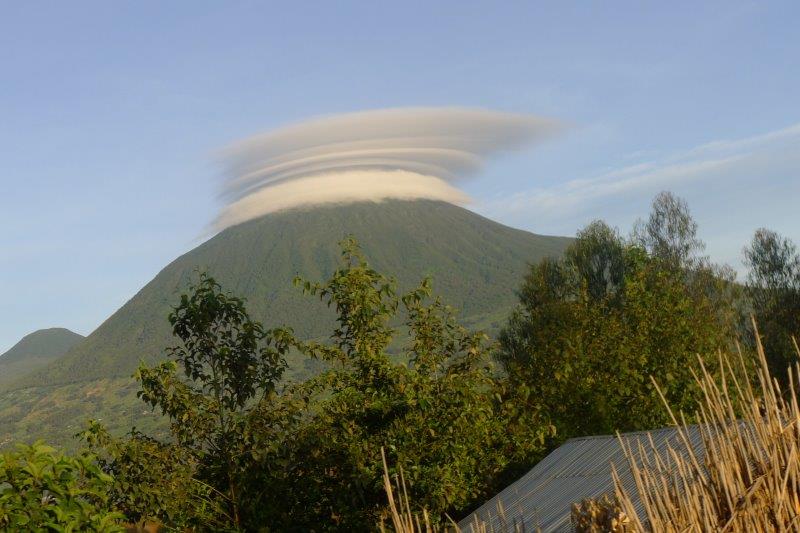
Oee of the 6 volcanoes in the morning with interesting clouds
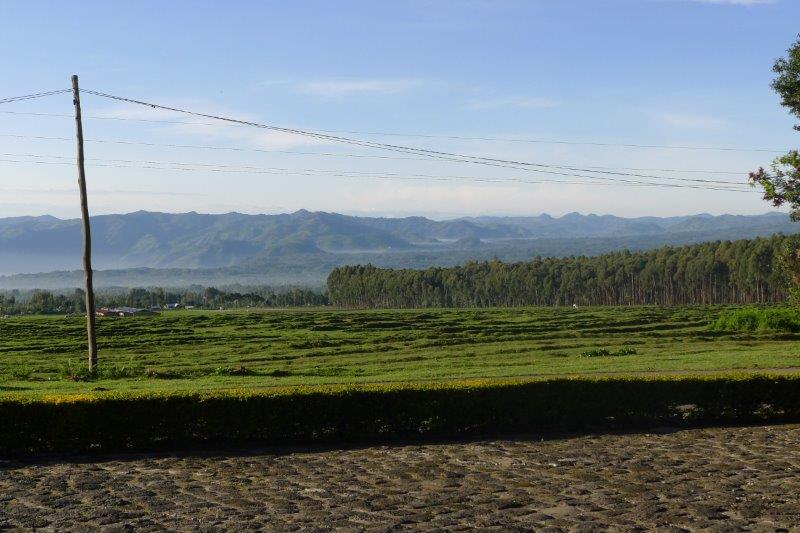
We all met here at 7 AM before the treks starts
Check-in time for the visits is 7 AM at Park Headquarters where our driver took copies of our passports to check us in. Everyone checks in here if you are doing the Gorilla Trek, Golden Monkeys trek, or a hike.
Before going any further, let me back up a few hours. The 7 AM check-in required us to get up at 5 AM (Yes, it is dark then.), eat breakfast about 5:30 AM and then go with our driver at 6 AM for the hour drive to the Headquarters.
How did we dress for this adventure? Long pants, wool sox pulled up over the pants, hiking boots and gaiters. These are to prevent nettles from sticking to our legs and nasty ants from crawling up legs between the pants and sox if the sox are under the pants (This happened to 3 people on our Golden Monkey Trek.) as well as to collect mud along the way. Leather gloves are recommended to protect hands from the nettles and to grab on to bamboo and plants to pull yourself either up the mountain and to help keep you from sliding down the mountain because of the mud.
All the literature warned us it could be cold at 8000 feet. Being good Coloradoans, we had layers with us – t-shirts, mosquito repellent long sleeve shirts and rain jackets – to go with the pants. Did we need them? We wore some combination of these clothes everyday on the hike but not because of the cold. The volcano is a rain forest – think humid – meaning Mark and Susan were never cold but we couldn’t prevent rain and used the rain jackets during the rainfall; we used the long sleeve shirt to save our arms from getting scratched up.
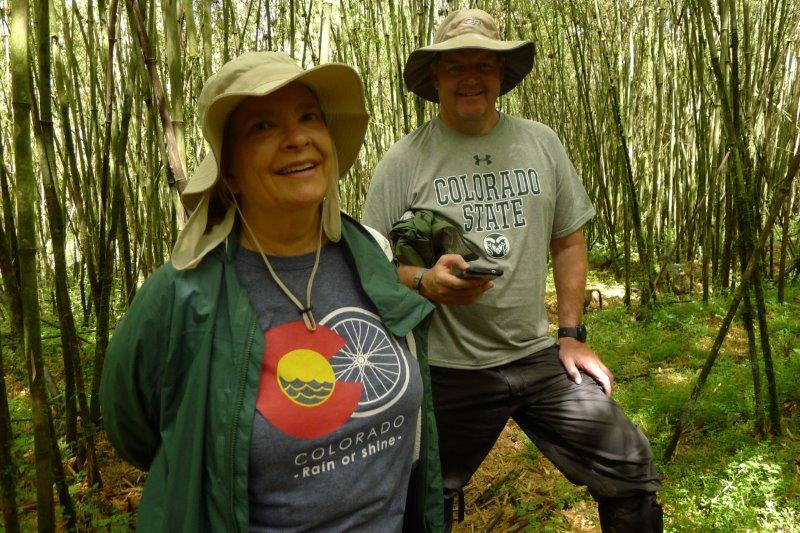
It was warm and we hadn’t reached any nettles, so no need for long sleeves yet.
Back to check-in … the drivers negotiate with the trekking guides for what kind of hike their customers want – easy, medium, or hard. Robert, our driver, was good and negotiated an easy family for the first day. He seemed to know all the trekking guides which is a good thing!
The gorilla group you are assigned is based on the hike difficulty and during high season, it’s tough to get an easy hike. A lot is based on age and even VIP status. It’s low season, making it a bit easier to get the family/hiking difficulty we wanted.
After being assigned a gorilla family, the group of eight meets with the trekking guide who is responsible for getting us to the gorillas. He gave us information about the gorilla family and trekking and we met the other members of the group.
Then it’s time for the last visit to the toilets – VERY clean – before heading out with our driver, Robert, to the trek starting point. Each gorilla family has a different starting point requiring a 10 to 30-minute drive to the starting point. At the starting point, everyone gets a walking stick to use if we wanted and we both opted for one. The porters can be hired there, too, and then it’s time to start the walk!
About the porters – Porters carry your backpacks which should have bottles of water and some snack food or lunch along with all the clothes you have. They also are amazing at pointing out where to step and helping the visitors up and down stones and steep inclines and muddy trails.
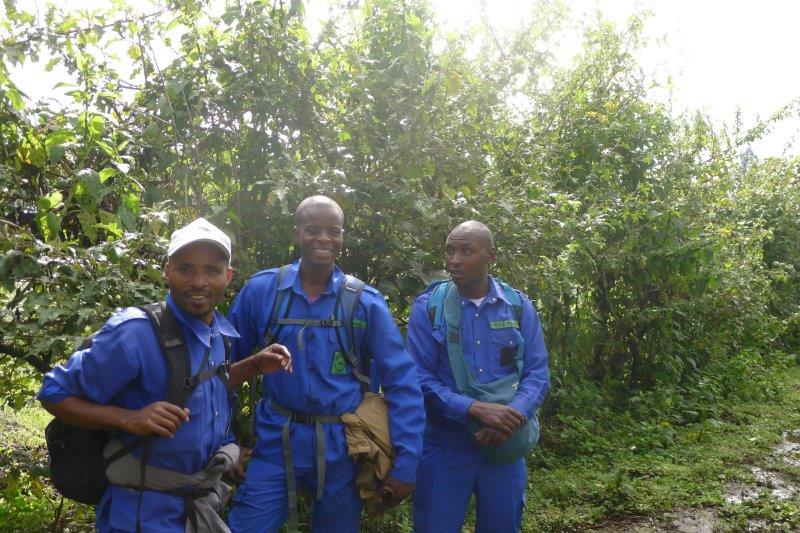
These are a few of the porters who helped on the trek.
The porters dress in blue with a name and number on each uniform. All of them are either ex-poachers or from a family of poachers with these jobs providing an alternative income to poaching. We were told that the average income for a person in Rwanda per month is only $45.
The porters show up each day to their assigned area and are assigned to visitors in a rotation, ensuring that everyone gets a chance to earn money. In low season, porters may only work 1 day a week. The official price to hire a porter is $10 US plus a tip and visitors can hire as many as you want. Mark and I each hired 2 porters each, both to help us and to help the economy. Given the cost of a permit, the cost of a porter is miniscule. We were rather surprised that more people didn’t hire porters given the age of some of our fellow trekkers. (Read that to mean older than we are!)
The trackers for each gorilla family are already in the forest looking for the families and stay in radio contact with the trekking guides to inform them about the family location. Our treks involved walking through potato and bean fields to get to the “wall”, the boundary of Volcanoes National Park. At this point the trek starts to go uphill, either gradually or steeply, and each group is joined by a park ranger armed with a gun. The rangers will scare off any elephants or water buffalo you might encounter (We never saw anything worse than big piles of buffalo poop.)
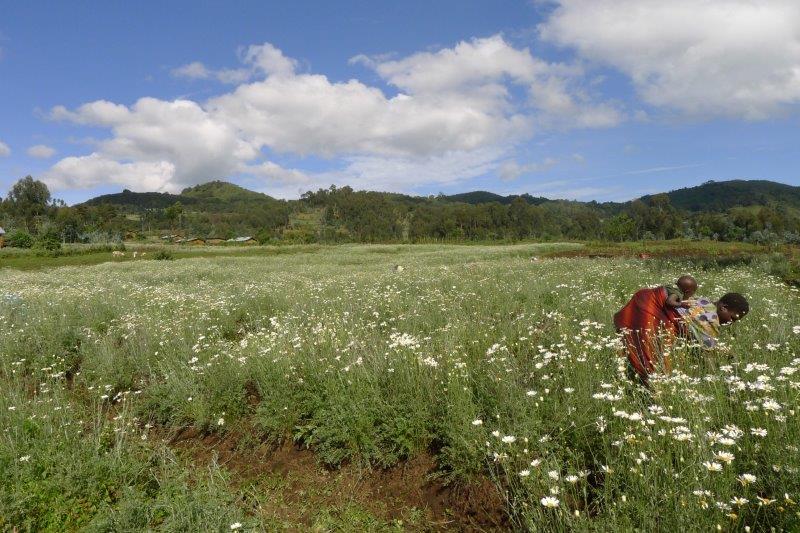
Pyrethrum, a natural insecticide, is made from these flowers
When the trekking group meets the tracker in the forest, you know you are close to the gorilla family and the excitement builds.
A side note … our trekking guide on day 1 used his cell phone in addition to the radio. We laughed that cell phone reception is better in the middle of the Rwandan National Park than it is in our house in the middle of Ft. Collins!
